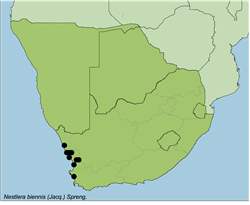Names and synonyms
Nestlera biennis (Jacq.) Spreng.
= Relhania biennis (Jacq.) Bremer
=Columellea biennis Jacquin
=Nestlera biennis (Jacq.) Sprengel
=Relhania reflexa Thunberg
=Stephanopappus reflexus (Thunb.) Lessing
=Nestlera reflexa (Thunb.) DC.
Type
Drege, J.F., Ebenezar, sand dunes, South Africa (HBG)
Derivation of names
Nestlera = after C.G. Nestler (1778 - 1832), Alsatian botanist, professor of botany and pharmacy, Strassbourg.
biennial = of 2 seasons' duration from seed to maturity and death
Diagnostic characters
Stiff upright growth form, older plants often christmas-tree shaped
Slender involucres with long, narrow, spreading apical limbs.
Linear cypselas with a white cup-like pappus, easily discernible in the old persistent capitula.
Description
Stiffly, erect, annual or short-lived perennial herb, 0.05-0.2(-0.5) m high. Main stem erect with ascending-erect branches, leafy, � laxly tomentose. Leaves alternate, spreading, slender, mid-ribbed, linear, 3-30 x 0.5-1.5 mm, glandular with stalked glands and sometimes laxly tomentose, obtuse. Capitula solitary, sessile, terminal. Involucre cup-shaped, 3-8 mm wide. Involucral bracts 15-35, in 5-8 indistinct rows, outer narrowly ovate, inner gradually longer and oblong with a spreading, scarious apical limb, entire or apically minutely serratulate, up to 11.5 x 2 mm, dorsally laxly villose, inner dorsally gland-dotted, acute to acuminate. Receptacle flat, epaleate. Ray florets 6-12, tube 1.6-2.8 mm long, with scattered, subulate-triangular hairs; lamina elliptic, 4-6 x 1.5-2.3 mm, 4-7-veined, apically with a blunt point, actually 3-lobed, but with lateral lobes much reduced. Disc florets 15-35, perfect; corolla 4.2-5.9 x 0.7-0.9 mm; tube with scattered, subulate-triangular hairs on upper half; limb narrowly cup-shaped-bell-shaped; corolla lobes 0.7-1 mm long, with a stalked gland at apex. Cypselas angular, linear, 4-6.5 x 0.5-0.8 mm, with scattered subulate-triangular hairs mainly apically; more hairy in ray florets. Pappus tubular-cup-shaped, somewhat unequal-sided, up to 1.5 mm long.
Flowering time
Mainly from September to November.
Distribution
From Cape Flats northwards into Namaqualand.
Known from about 15 collections.
Habitat
Sandy coastal flats and streets of inland sand dunes.
Notes
During favourable years it can survive for more than one season. Although this species is not often collected, it is usually quite common where it occurs.
References
ANDERBERG, A.A. 1991. Taxonomy and phylogeny of the tribe Gnaphalieae (Asteraceae). Opera Botanica 104: 50-53.
BREMER, K. 1976. The genus Relhania (Compositae). Opera Botanica 40.
LAWRENCE, G.M. 1989. Taxonomy of Vascular Plants. Macmillan Publishing Co., New York.

_sml.jpg)
_sml.jpg)